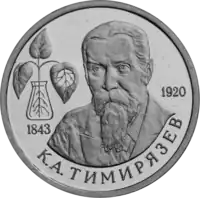Kliment Timiryazev | |
|---|---|
 Timiryazev in 1911 | |
| Born | 22 May 1843[1] |
| Died | 28 April 1920 (aged 76)[1] |
| Alma mater | Saint Petersburg State University[1] |
| Awards | Croonian Lecture (1903) |
| Scientific career | |
| Fields | Botany, physiology |
| Institutions | Moscow State University[1] |
| Thesis | Spectral analysis of chlorophyll[1] (1871) |
Kliment Arkadievich Timiryazev, sometimes Timiriazev (Russian: Климент Аркадьевич Тимирязев; 22 May [O.S. 3 June] 1843 – 28 April 1920) was a Russian Imperial botanist and physiologist and a major proponent of the Evolution Theory of Charles Darwin in Russia.[2] He founded a faculty of vegetable physiology and a laboratory at the Petrovskoye Academy.
Biography
Timiryazev was born to Arkady Semyenovich Timiryazev, a Russian statesman, and Adelaida Bode, an English woman of French origin, who later received Russian citizenship. He had at least three brothers: Nikolai (1835–1906), a military officer, Dimitri (1837–1903), a specialists in statistics, and Vasily (c. 1840–1912), a writer. Timiryazev was first educated by private teachers at home. In 1861 he entered the Saint Petersburg University and graduated with honors from the faculty of physics and mathematics in 1866. Two years later he published his first article, on a device for studying breakdown of carbon dioxide, and was sent abroad, where he studied under Wilhelm Hofmeister, Robert Bunsen, Gustav Kirchhoff, Marcellin Berthelot, Hermann von Helmholtz, Jean-Baptiste Boussingault and Claude Bernard. Upon returning to Russia in 1871 he defended a PhD on spectral analysis of chlorophyll and was appointed as professor of Petrov's Academy of Agriculture, until its closure in 1892. Since 1877 he also lectured at the Moscow State University. His research work was devoted to photosynthesis-related phenomena. He also pioneered the use of greenhouses for agricultural research in Russia, which he initiated in early 1870s. He was a member of the Russian Academy of Sciences (since 1890), Royal Society (1911) and Botanical Society of Scotland (1911), and an honorary professor of the Saint Petersburg University, Kharkov University, University of Glasgow (1901), University of Cambridge (1909) and University of Geneva (1909).[1][3]
In 1911 Timiriazev put forth the idea of organizing scientific research in special institutes outside the universities, which later became the dominant Soviet trend. Shortly before his death in 1920, he publicly endorsed the Bolshevik regime, thus helping to forge the pact between research-oriented scientists and the Soviet government.[4]
Darwinism
Timiryazev was a major proponent of the evolution theory of Charles Darwin in Russia. In 1877, he visited and met Darwin at Down House.[5][6]
Timiryazev promoted Darwinism in his works and prepared a Russian translation of On the Origin of Species. However, he was highly critical of the term "struggle for existence" which he rejected. He believed that it was an unfortunate metaphor with negative social implications and stated that Darwinism could be taught without using the word "struggle".[7]
At the University of Moscow, Alexander Oparin attended private lectures of Timiryazev. These lectures on evolution were highly influential to Oparin. He also lectured on Darwinism at his flat in Moscow.[8]

Legacy
Timiryazev Agricultural Academy, the Timiryazevskaya station of the Moscow Metro, the lunar crater Timiryazev and the asteroid 6082 Timiryazev are named after him. The Regional Universal Scientific Library in Vinnytsia, Ukraine, used to be named after Kliment Timiryazev, the named was changed at the end of 2022, however, in the wake of the Russian invasion of Ukraine. The Timiryazev State Museum of Biology in Moscow is also named after him.[1]
At the beginning of the Tverskoy Boulevard in Moscow there is a statue of Timiryazev which was unveiled on 4 November 1923, sculpted by Sergey Merkurov and laid out by the architect Osipov. Timiryazev is depicted in the gown of Cambridge University where he was awarded an honorary doctorate. The granite pedestal bears the inscription of 'the curve of plant physiology' which Timiryazev elucidated. In October 1941 the statue was overturned by a Fascist bomb, but after a few hours it was back in its place. Its lower half still bears the marks caused by bomb splinters.
Selected publications
- The Life Of The Plant (1958 English edition)
References
- 1 2 3 4 5 6 7 8 9 "Тимирязев Климент Аркадьевич" in Great Soviet Encyclopedia
- ↑ "Biology" in Great Soviet Encyclopedia
- ↑ Тимирязев, Климент Аркадьевич in Brockhaus and Efron Encyclopedic Dictionary.
- ↑ Kozhevnikov, A. B. (2004). Stalin's Great Science: The Times and Adventures of Soviet Physicists. Imperial College Press. p. 14. ISBN 9781860944208.
- ↑ Chela-Flores, Julian. (2012). The New Science of Astrobiology: From Genesis of the Living Cell to Evolution of Intelligent Behaviour in the Universe. Springer. p. 180. ISBN 978-1-4020-2229-6 "Darwin influenced a young Russian scientist, who went to meet him in his home in Down House, near Farnborough in Kent, England. The name of the young scientist was K. A. Timiryazev (1843–1920)."
- ↑ Timiriazev, Kliment. [1877]. "A Visit to Darwin at Down". From: Historical note K. A. Timiriazev: A visit to Darwin, with notes by Leon Bell. Archipelago 9 (2006): 47–58.
- ↑ Düwell, Marcus; Rehmann-Sutter, Christoph; Mieth, Dietmar. (2008). The Contingent Nature of Life: Bioethics and the Limits of Human Existence. Springer. p. 348. ISBN 978-1-4020-6762-4
- ↑ Margulis, Lynn; Matthews, Clifford; Haselton, Aaron. (2000). Environmental Evolution: Effects of the Origin and Evolution of Life on Planet Earth. MIT Press. p. 86. ISBN 0-262-63197-0